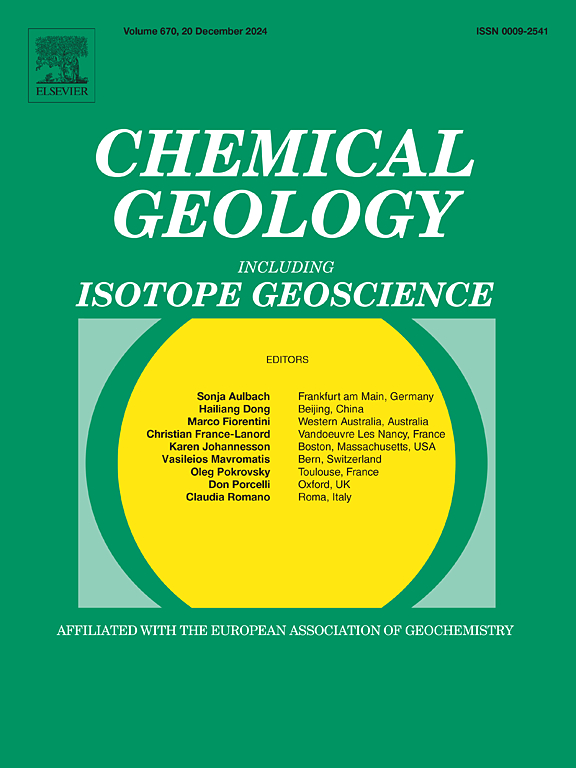利用单独居石的反应性解读多造山相(泰国Inthanon核杂岩)
IF 3.6
2区 地球科学
Q1 GEOCHEMISTRY & GEOPHYSICS
引用次数: 0
摘要
在受几处造山覆层影响的地块中,限制构造-热事件的时间是一项挑战。需要对岩浆以及低到高变质反应敏感的地球时计。我们利用泰国北部Inthanon岩心杂岩的几个岩性中的活性副矿物单氮石来解释这个多重变形和变质的地壳块体的演化。我们根据独居石的组成和区带定义了不同的区域,并利用结构观察推断出独居石的形成反应。EPMA的化学测年被用作区分不同年龄人群的侦查工具,然后是LA-ICP-MS的同位素测年来评估准确性和一致性。利用LA-ICP-TOF-MS对复杂分带的独居石颗粒进行制图,确定了不同年龄的区域以及可能不一致的U - Pb日期区域。在副长岩、云母岩、正长岩或(异)花岗岩样品中的独居石中发现了大约240-210、80-70和40-20 Ma的三个年龄群。在~ 240和215 Ma (Grt±Sil片麻岩)新生长的独居岩域记录了与印支造山运动同时代的中P - T变质环的前进和后退部分。80 Ma左右形成的过度生长归因于新特提斯俯冲期间角闪岩相叠印造成的石榴石碎裂。约240 Ma形成的岩浆独居石(Bt±Ms.),在40 Ma部分重结晶,表明与印度-欧亚碰撞同时发生的高变质条件。局部,大约20 Ma的年轻高t脉冲触发了新的独居石生长。独居石倾向于(重新)生长在缺钙的大块成分(变质沉积物)中,而在富钙的大块成分(花岗岩)中再结晶。我们的研究表明,在一个岩心杂岩中,来自不同岩性的独居石有可能记录跨越2亿年的生长/再结晶历史,从而有助于识别复杂构造-热演化的各个阶段。本文章由计算机程序翻译,如有差异,请以英文原文为准。
Deciphering multiple orogenic phases with the reactive help of monazite (Inthanon core complex, N Thailand)
Constraining the timing of tectono-thermal events in a terrane affected by several orogenic overprints is challenging. Geochronometers sensitive to magmatic as well as low- to high-grade metamorphic reactions are required. We use the reactive accessory mineral monazite in several lithologies from the Inthanon core complex (N Thailand) to decipher the evolution of this multiply deformed and metamorphosed crustal block. We define distinct domains based on the composition and zoning of monazite and infer monazite-forming reactions using textural observations. Chemical dating by EPMA is used as a reconnaissance tool to distinguish between different age populations, followed by isotopic dating by LA-ICP-MS to assess accuracy and concordance. LA-ICP-TOF-MS mapping of complexly zoned monazite grains is used to identify domains of different ages together with zones of potentially discordant U - Pb dates.
Three age populations at ca. 240–210, 80–70 and 40–20 Ma are found in monazite from paragneiss, micaschist, orthogneiss or (meta-)granite samples. Newly grown monazite domains at ∼240 and 215 Ma (Grt ± Sil gneiss) record the prograde and retrograde parts of a medium P - T metamorphic loop contemporary with the Indosinian orogeny. Overgrowths formed around 80 Ma are ascribed to garnet breakdown due to an amphibolite-facies overprint during Neo-Tethyan subduction. Magmatic monazite (Bt ± Ms. orthogneiss), which formed at ca. 240 Ma, partially recrystallized at 40 Ma, indicating high-grade metamorphic conditions concurrent with the India-Eurasia collision. Locally, a younger high-T pulse at ca. 20 Ma triggered renewed monazite growth.
Monazite tends to (re-)grow in Ca-poor bulk compositions (metasediments) but recrystallizes in Ca-richer ones (granitoids). Our study demonstrates that monazite from diverse lithologies within a core complex has the potential to record a growth/recrystallization history spanning over 200 million years, thus helping to identify individual stages of complex tectono-thermal evolutions.
求助全文
通过发布文献求助,成功后即可免费获取论文全文。
去求助
来源期刊

Chemical Geology
地学-地球化学与地球物理
CiteScore
7.20
自引率
10.30%
发文量
374
审稿时长
3.6 months
期刊介绍:
Chemical Geology is an international journal that publishes original research papers on isotopic and elemental geochemistry, geochronology and cosmochemistry.
The Journal focuses on chemical processes in igneous, metamorphic, and sedimentary petrology, low- and high-temperature aqueous solutions, biogeochemistry, the environment and cosmochemistry.
Papers that are field, experimentally, or computationally based are appropriate if they are of broad international interest. The Journal generally does not publish papers that are primarily of regional or local interest, or which are primarily focused on remediation and applied geochemistry.
The Journal also welcomes innovative papers dealing with significant analytical advances that are of wide interest in the community and extend significantly beyond the scope of what would be included in the methods section of a standard research paper.
 求助内容:
求助内容: 应助结果提醒方式:
应助结果提醒方式:


